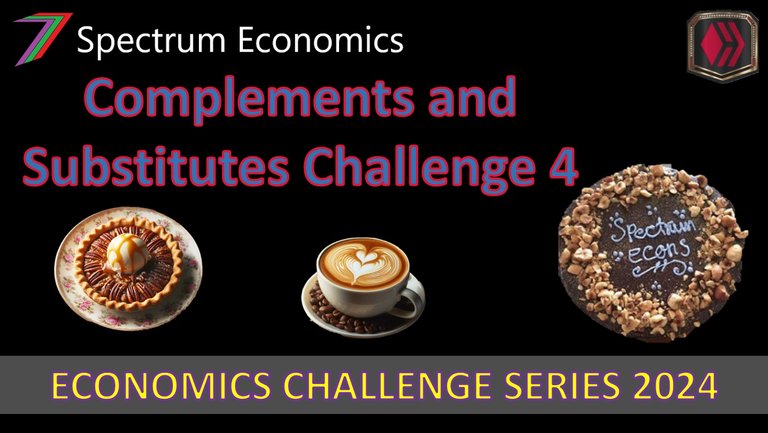Hi Everyone,
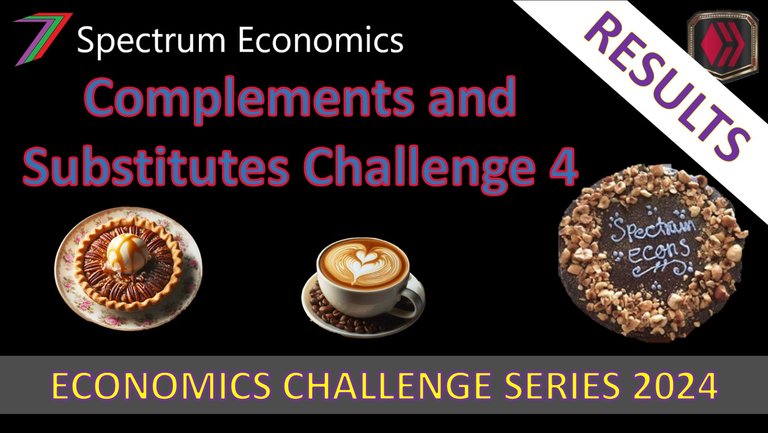
Welcome to the Economics Challenge Series for 2024. For July and August, I am running an economics challenge series. The series consists of seven challenges. All the challenges will commence in July and early August. I will publish and announce the results in August.
Six of the seven challenges from last year's Challenge Series are returning. The Tax Game from 2022 is replacing the business version of the Buying and Selling Game. Below is the list of challenges.
- Challenge 1: Ice Cream Game
- Challenge 2: Game Theory Game
- Challenge 3: Pick-a-Door
- Challenge 4: Complement vs. Substitute
- Challenge 5: The Buying and Selling Game
- Challenge 6: Even-to-Win
- Challenge 7: Tax Game
Each challenge could reward winners with as much as 60 Hive Power. The value of the prize will depend on the level of participation. For each new participant, the prize will increase by 5 Hive Power. This will continue until 60 Hive Power is reached (12 participants). The first 12 participants will also receive a 50% upvote from this account.
In addition to the prize money, the top few participants will be given points. These points will be used to determine the overall challenge series winner. This winner may receive as much as 80 Hive Power. The value of the prize will equal the sum of the number of participants across all challenges. This will continue until 80 Hive Power is reached.
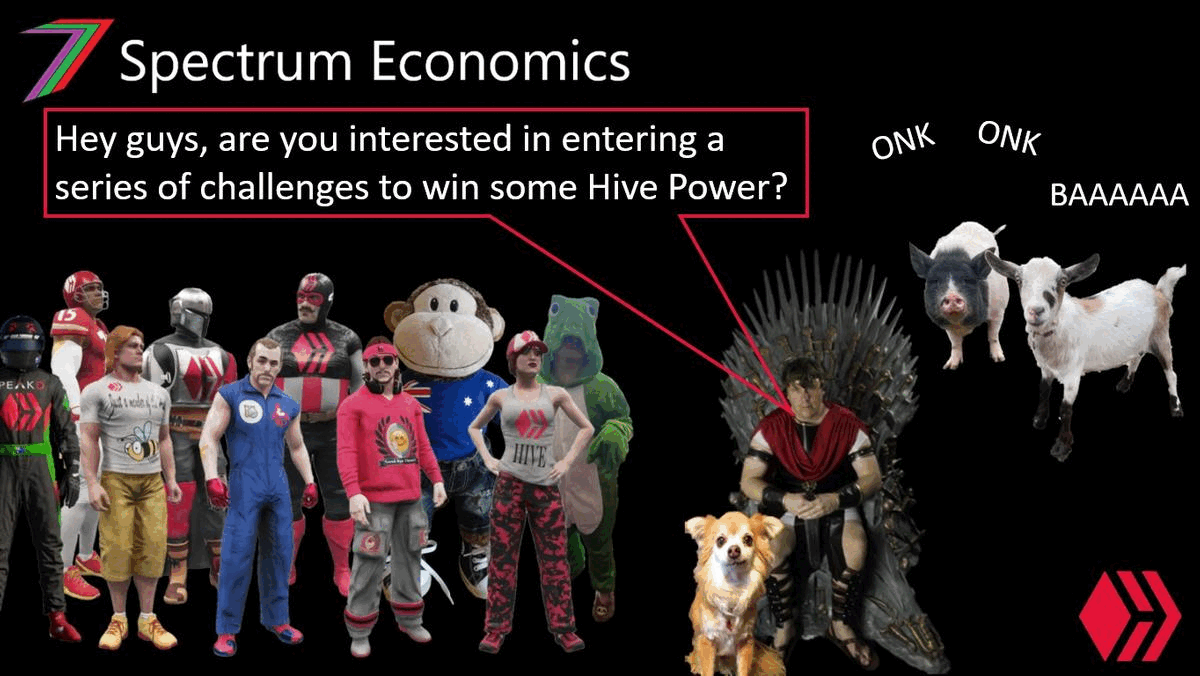
For more information on the challenge series, I recommend that you read my post from last year. This year’s Challenge Series is run the same way as last year’s.
What is the Complements and Substitutes Challenge?
In this challenge, participants were required to price two food and one drink item sold at the same store. For this challenge, the two food items were pecan pies, and chocolate cakes, and the drink item was coffee. Pecan pies and chocolate cakes were assumed to be substitutes for each other, and coffee was assumed to be complementary to both pecan pies and chocolate cakes.
If the food or drink items are substitutes, they are in competition with each other. Therefore, if a person buys a pecan pie, they were assumed to be less likely to buy a chocolate cake. If food or drink items are complementary, buying one encourages the buying of the other. We assumed coffee was bought with a pecan pie or chocolate cake because they made a person thirsty. However, many people may still wish to buy just one item on its own. Therefore, coffee was not assumed to be perfect complementary to either pecan pie or chocolate cake.
The participants were required to set the prices of pecan pies, chocolate cakes, and coffees. The aim was to maximise total profits. Participants were provided with variable costs and inverse demand functions for the items. There were no fixed costs, and participants were not required to work with a budget. For this question, no information was required to be generated by any model.
The format of the required entry is explained in detail in the challenge itself.
For a more detailed explanation, you can access the challenge post using the following link.
Results of Complements and Substitutes Challenge
This is the most mathematical and theoretical challenge of this series. An optimal combination of prices for all three goods (pies, cakes, and coffee) can be determined mathematically based purely on the information provided.
For this challenge, profit is determined by the following equation.
Profit = Price × Quantity - Variable Cost (per unit) × Quantity
Participants are required to set the prices, and the quantities are determined based on these prices and the inverse demand functions provided. Below are the inverse demand functions for pecan pies, chocolate cakes, and coffee.
Inverse Demand Functions
PP = 10 – 0.02QP – 0.01QCa + 0.005QCo
PCa = 14 – 0.025QCa – 0.01QP + 0.005QCo
PCo = 6 – 0.015QCo + 0.01QP + 0.01QCa
Legend:
PP: Price for pecan pies
PCa: Price for chocolate cakes
PCo: Price for coffee
QP: Quantity for pecan pies
QCa: Quantity for chocolate cake
QCo: Quantity for coffee
To determine quantity demanded, the inverse demand functions need to be rearranged so that the quantities become the subject of the equations instead of price. Below are the rearranged equations, also referred to as demand functions.
Demand Functions
QP = (27.968 - 3.952PP + 1.216PCa - 0.912PCo)/0.05776
QCa = (8.96 + 0.32PP - 0.8PCa - 0.16PCo)/0.0152
QCo = (2.12 - 0.06PP - 0.04PCa - 0.16PCo)/0.0019
The provided variable costs can be entered directly into the profit equation. Variable costs are below.
Variable Costs
AVCP = 3.2
AVCCa = 4
AVCCo = 0.2
Legend:
AVCP: Average Variable Cost of Pecan Pies
AVCCa: Average Variable Cost of Chocolate Cake
AVCCo: Average Variable Cost of Coffee
Table 1 contains the prices set by all the participants, the quantities demanded at these prices, and the profits obtained from these prices and quantities.
Table 1: Price, Quantity, and Profit
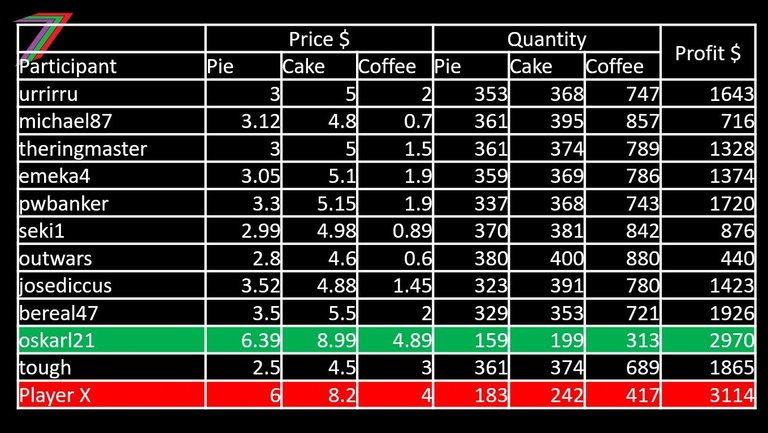
The winner of Challenge 4 is @oskarl21. @oskarl21 obtained the highest profit by a considerable margin. It was only slightly lower than the highest possible profit, see Player X for an approximation. He obtained a profit of $2970. @bereal47 came in second, obtaining a profit of $1926.
As there were 11 participants, the prize for this challenge is 55 Hive Power. @oskarl21 wins 37 Hive Power and 40 points. @bereal47 wins 18 Hive Power and 20 points.
Challenge Tips and Analysis
I recommend rearranging the inverse demand functions to make the quantity the subject of the equation. This makes it easier to determine the impacts of raising and lowering prices. Optimum pricing for maximising revenue and profits can be obtained using calculus. This is reasonably complicated for anyone not mathematically inclined.
Alternately, participants can use trial-and-error methods of raising and lowering prices. With the use of Microsoft Excel, it is possible to find a combination of prices that is very close to the optimum price. I would argue this method would be preferred over calculus, which is tedious and the chances for error are quite high.
Overall Series Score
After four challenges, the overall scores for the Challenge Series are as follows:
| Position | Participants | Points |
|---|---|---|
| 1 | Emeka4 | 70 |
| 2 | Oskarl21 | 40 |
| 3 | Urrirru | 35 |
| 4 | Bereal | 35 |
| 5 | Theringmaster | 15 |
| 6 | Micheal87 | 10 |
| 7 | Adese | 5 |
This table will be updated in every results post.
My New Book, Sapien Loop

I have published an ebook on Amazon; it is titled ‘Sapien Loop: End of an Era’. The book is fiction. I do not normally write fiction. However, I felt it was appropriate considering what is happening in the world today. Freedom is the most important thing we have, but we are gradually losing it. I have covered this in many of my posts.
In the story, most citizens do not understand the concept of freedom because they have never really experienced it. In essence, the story is about an alien world that might represent our not-so-distant future. There are many other elements to the story that are an abstract and exaggerated version of our reality. I believe this book to be an important read, and I believe it has the potential to change the way you think.
Brief Summary of Sapien Lopp
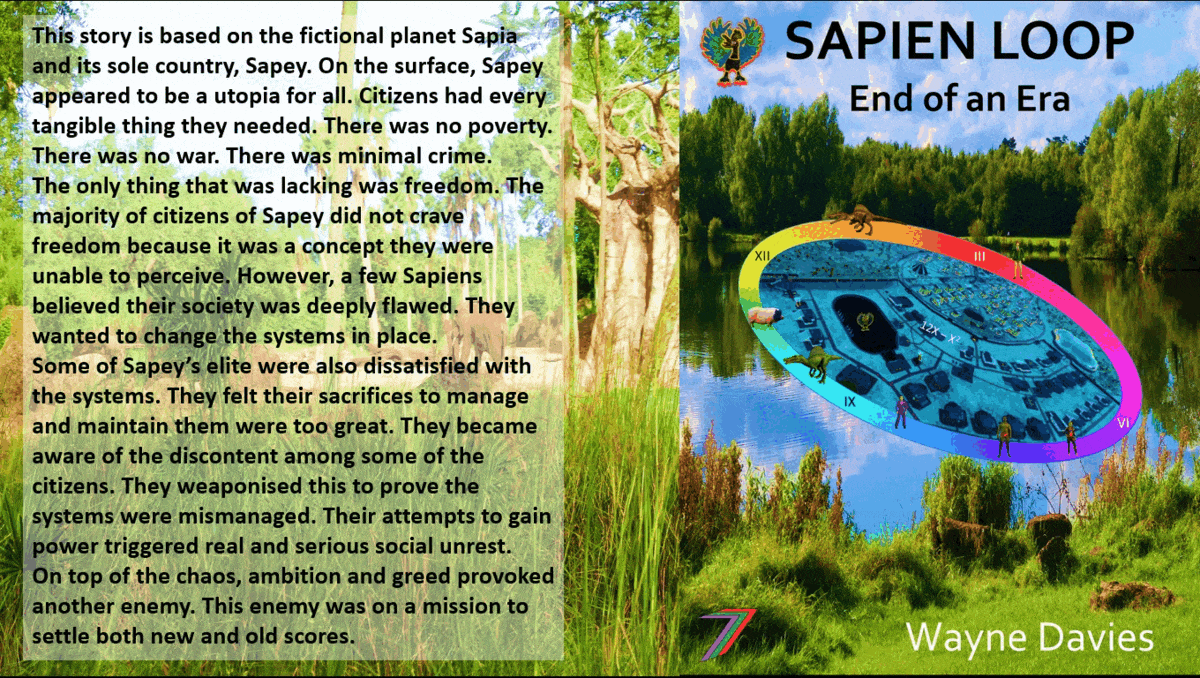
This story is based on the fictional planet Sapia and its sole country, Sapey. Sapey is portrayed as a form of utopia for all its citizens. No poverty. No war. Almost no crime. Opportunities for all.
This was enough for most citizens, but not all. In one of the small regions, some of the citizens had become discontent. They felt something important was missing in their lives. Their discontent did not go unnoticed. Some of the Sapey elite wanted to weaponise this discontent to gain more power. This created more chaos than they anticipated. This led to further widespread social unrest.
On top of the chaos, ambition and greed provoked another enemy. This enemy was on a mission to settle both new and old scores.
If you want to buy a copy of the book, below are links to the relevant Amazon websites for each country it is available in. The book is priced at approximately US$5.08.
- Amazon USA
- Amazon UK
- Amazon Germany
- Amazon France
- Amazon Spain
- Amazon Italy
- Amazon Netherlands
- Amazon Japan
- Amazon Brazil
- Amazon Canada
- Amazon Mexico
- Amazon Australia
- Amazon India
I am also running monthly contests where participants are required to answer questions based on the book. The prize is 30 Hive Power plus upvotes for the first twelve entries. You can recover the cost of the book with just one win.
Hive: Future of Social Media

Spectrumecons on the Hive Blockchain

